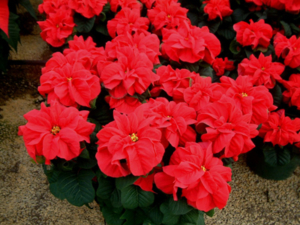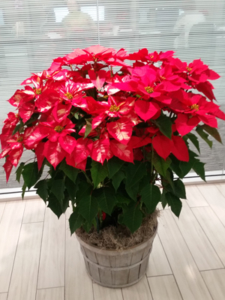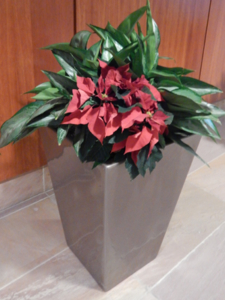Common Name: Poinsettia
Light Needs
Strong light
Water Requirements
Water thoroughly
Description:
Bush or tree
Most commonly used varieties: Euphorbia pulcherrima ‘St. Louis Red’
The colorful parts of a poinsettia, commonly thought of as the “flower,” are actually modified leaves called bracts. The true flowers are the small yellow structures, called cyathia, in the center of the colorful bracts. When selecting poinsettias for your accounts, avoid plants tinged with too much green around these bract edges. Make sure that the secondary, smaller bracts that surround the cyathia are fully colored. If the secondary bracts are not fully colored, the plant will quickly fade and lose color in your account.
An abundance of dark, rich green foliage is not only attractive, but is a vital sign of good plant health. Look for plants with lush green foliage that is undamaged and free of discoloration. The foliage should appear dense and plentiful, all the way down to the soil line. This is a good indication that the plants have an active, healthy root system and that they have been given adequate bench space in the greenhouse.
Look for plants that are balanced, full and attractive from all angles. Proper proportion of plant height and shape to the pot size is the key to an aesthetically pleasing poinsettia. A generally accepted standard is that the plant should be about 2 1/2 times bigger than the pot size.
Signs of durability and freshness in poinsettias include strong, stiff stems; good leaf and bract retention; and no signs of wilting, breakage or drooping or moldy soil. Be wary of poinsettias displayed in plastic or paper sleeves. Although packaged poinsettias offer convenience, the quality of the plants will deteriorate the longer they remain in their sleeves. More than 36 hours in a sleeve will cause permanent damage.
When transporting poinsettias, protect the plants from chilling winds or temperatures below 50 degrees F. Even a few seconds of exposure to freezing weather can destroy a beautiful poinsettia plant.
Once you get your poinsettia to your account, keep in mind it will thrive on strong light. Exposure to at least six hours daily is recommended. They need lots of light to keep looking their best. To prolong the bright color of poinsettia bracts, daytime temperatures should not exceed 75 degrees F.
Poinsettias require soil that dries down between waterings. Water thoroughly when the soil surface feels dry to the touch. Do not allow the poinsettia to sit in any water; this could result in root rot and could kill the plant. This is especially important if they are placed in low light!! The best soil for a poinsettia is one that is porous and drains quickly.
Be sure to sleeve for transport to keep them warm during delivery. Use care when removing the sleeves for the stems can be brittle.
Fungus, mites and thrips.






